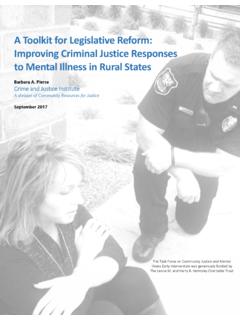Transcription of Interventions for High-Risk Youth: Applying Evidence-Based ...
1 Interventions for High-Risk youth : Applying Evidence-Based theory and Practice to the Work of Roca January 26, 2006. Prepared by Crime and Justice Institute 355 Boylston Street 5th Floor Boston, MA 02116-3313. T: F: A division of Community Resources for Justice Interventions for High-Risk youth : Applying Evidence-Based theory and Practice to the Work of Roca INTRODUCTION. Roca is a values- based , outcomes-oriented, youth and young adult development organization in Chelsea, Revere, and East Boston, Massachusetts. The agency's mission is to promote justice through creating opportunities for young people to lead happy and healthy lives.. Roca chooses to pursue this mission with some of the most marginalized youth in the community, and works with those youth to achieve self-sufficiency and live out of harm's way.
2 After nearly two decades of experience serving this population, Roca is undergoing a thoughtful restructuring to clearly define and measure the work that they do, and ultimately to institutionalize practices that fulfill the agency's mission and goals. As part of this transition to Evidence-Based practice, Roca is reviewing existing theory and practice that are applicable to its work. This document is a component of that effort. This literature review focuses on research in criminal and juvenile justice, delinquency prevention, and behavior change. Roca has previously engaged in a review of relevant literature in the field of youth development;1 this review will expand upon previous work by viewing Roca through the lens of another discipline.
3 This research is appropriate to apply to Roca because many of its participants are either involved with the court, or at risk of becoming court-involved. The disengaged and disenfranchised youth with whom Roca works possess several of the characteristics that put youth in contact with the criminal justice system, including dysfunctional family relations, alcohol and drug problems, and anti-social ,3 The criminal and juvenile justice fields have developed effective, evidence - based practices that can inform Roca's work and provide support for Roca's theory of Cited works include theoretical and practical research in delinquency prevention and intervention, and pro-social skill building for High-Risk youth . Consistent with Roca's model, the review considers not only programming, but the engagement of individuals and institutions in the change process.
4 Of note, Roca identifies itself as a youth development organization, not as a clinical service provider. Therefore, this review does not offer a review of the clinical practices that have proven successful with court-involved and High-Risk youth , as these practices are outside the scope of Roca's services. 1. Wheeler, W. (2004) Claiming their Place: Creating Pathways for Employment, Education, and youth Development for the Most Marginalized and At-Risk youth Through Roca's VIA Project. Takoma Park, MD: Innovation Center for Community and youth Development. 2. Gendreau, P., Little, T. and Goggin, C. (1996) A Meta-Analysis of the Predictors of Adult Offender Recidivism: What Works! , Criminology 34(4): 575 607. 3. Andrews, & Bonta, J.
5 (1998). The Psychology of Criminal Conduct. Cincinnati: Anderson Publishing Co. 4. Hunter, (June 2006) Roca theory of Change. Unpublished. Crime and Justice Institute 1. ROCA'S APPROACH. Roca works with some of the most challenging populations in the community: those youth who are not able to conform to the requirements of traditional education and human service programs; and those who need caring, creative, personalized attention and programming in order to become engaged and ultimately make life changes. Roca defines its work in terms of core values, core strategies, and outcomes. The values of belonging, generosity, competency, and independence infuse all of Roca's work and inform their Interventions with youth ; Roca's core strategies form the measurable processes of Roca's daily work, and the outcomes represent the end result of that work.
6 This model is discussed in detail in other Roca publications,5 but the following outlines the basic theoretical underpinnings. Roca's core strategies include outreach and street work, transformational relationships, peacemaking circles, and engaged institutions. While each is distinct, these strategies are built on the importance of developing a strengths- based , pro-social support network for youth . That network can include youth workers, family, friends, and community groups, and it supports the youth as he or she plans for and engages in positive behavior change and builds healthy relationships. As the discussion below demonstrates, there is a great deal of evidence that these types of pro-social engagement lead to positive outcomes for youth .
7 Roca's programmatic strategies include life skills education, employment, and academic instruction. Research has demonstrated multifaceted links between these factors and either reduction of risk or increase in self-sufficiency. Many types of educational and vocational curricula have been proven effective in improving outcomes for youth , while many others have been proven ineffective; the type of programming used and the way it is implemented makes a profound difference. In addition, education or vocational programs alone are insufficient to reduce the likelihood of further court involvement for High-Risk youth . This review of literature highlights these nuances, and references the literature where they are discussed in more depth.
8 Though Roca is able to define discrete phases in its work, in reality the model represents a continuum of meeting a youth where he or she is, and then maintaining a partnership that helps the youth to achieve success. Rather than address each component individually, this literature review discusses theory and practice that is applicable to the model overall, with reference to individual components. 5. Hunter, (June 2006) Roca theory of Change. Unpublished. Crime and Justice Institute 2. High-Risk POPULATIONS. In addition to defining its model, Roca has also defined the populations of High-Risk youth with whom it works: young adults ages 14-24 who are gang-involved, immigrants or refugees, young parents, or disengaged/dropout youth .
9 Each of these groups has its own distinct needs, and, in many cases, a dedicated body of literature that warrants some discussion before addressing the more general literature relevant to Roca's model. Gang-Involved youth For nearly as long as gangs have been recognized as a problem, various authorities have sought to intervene to prevent youth from joining gangs and deter gang-involved youth from gang-associated crime and violence. Soon after their implementation, these Interventions became the subject of evaluation by interested social scientists. Beginning with Frederick Thrasher's evaluation of the efforts of the New York City Boys Club in 1936,6 researchers have sought to define the key aspects of effective gang Interventions and understand the process by which youth become involved in gangs.
10 Interest in gang Interventions peaked in the late 1980s and 1990s, when the gang problem received a great deal of national attention as communities and police perceived that the gang problem was intensifying. In recent years, the scope of the gang problem has appeared to decrease or at the very least remain Some recent research has sought to identify risk factors associated with youths becoming involved with gangs. A study of youths in Rochester, NY, for example, found that gang membership was predicted by relationships with delinquent peers and early sexual ,9 In a study of Seattle youth , researchers examined risk factors in the individual, family, peer group, school, and community. Risk factors that they found to be important included: Anti-social behavior, and associating with anti-social peers and siblings.










